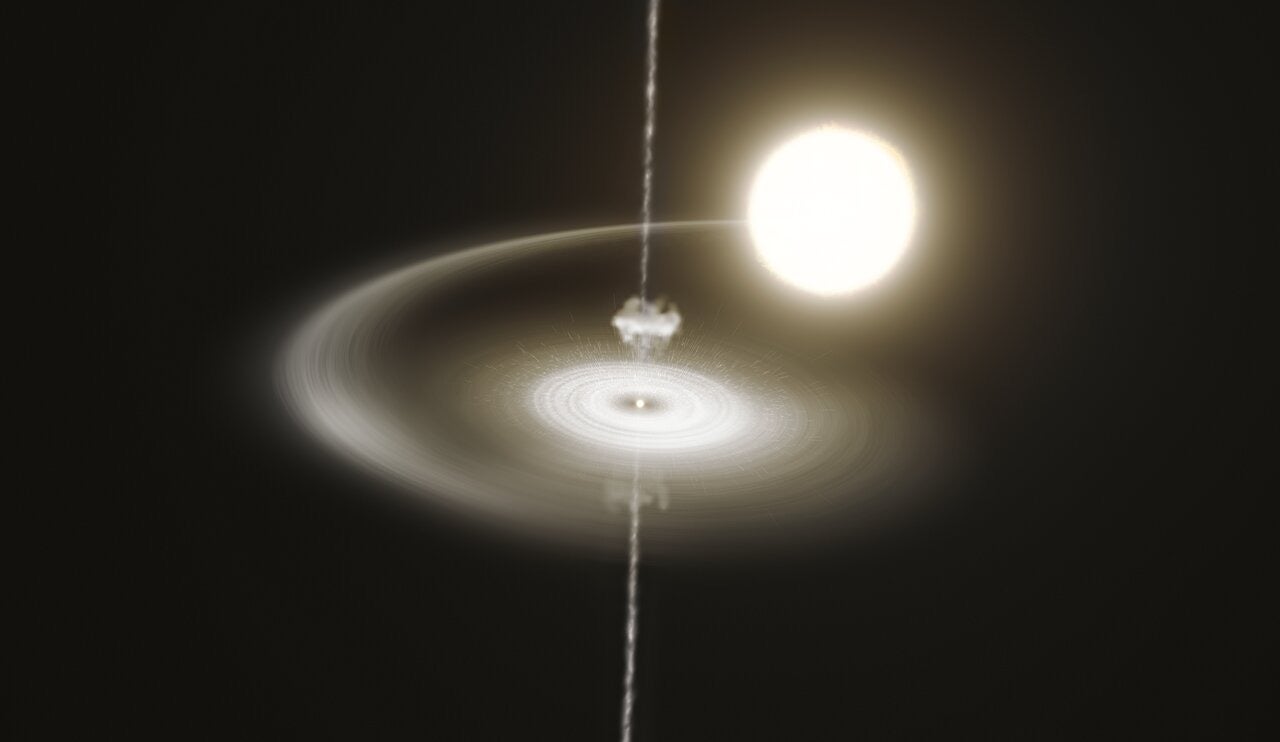
An international group of scientists and a massive observing campaign may have uncovered the reason behind a distant pulsar’s flashy behavior. This pulsar, dubbed PSR J1023+0038, has two different modes of brightness — and switches between them almost constantly, which may be due to sudden ejections of matter.
“We have discovered that the mode switching stems from an intricate interplay between the pulsar wind, a flow of high-energy particles blowing away from the pulsar, and matter flowing towards the pulsar,” Francesco Coti Zelati, an observational astrophysicist and study author at the Institute of Space Sciences in Barcelona, said in a statement. Researchers published details on the pulsar today in the journal Astronomy and Astrophysics.
Beacons of the cosmos
Pulsars are the dead remnants of massive stars that exploded in a supernova. Though they produce no internal nuclear fusion, they spin quickly, generate strong magnetic fields, and emit beams of light into space. When such a beam sweeps across Earth, its star appears to pulse in brightness in radio waves.
The most rapidly rotating pulsars have revolution periods of less than 30 milliseconds — spinning hundreds of times per second — and are called milliseconds pulsars (MSPs). Scientists think they achieve these rotation rates by periodically pulling in material from a nearby companion star, which falls onto the pulsar and spins them up. In total, there are about 3,000 known MSPs.
Located around 4,500 light-years away within the constellation Sextans, the millisecond pulsar PSR J1023+0038 closely orbits a companion star. When it was identified in 2007, it appeared to be a normal radio pulsar. But archival data showed that it was the same object as one that astronomers had previously identified as an X-ray binary system — a pair of stars where one is stealing matter from the other, forming a hot accretion disk capable of emitting X-rays. Follow-up observations showed that by 2007, that accretion disk was gone.
This earned J1023 the distinction of one of the first known transitional millisecond pulsars (tMSPs) — an object that can switch between a radio pulsar state and an active low-luminosity X-ray disk. tMSPs represent a key period in the lives of MSPs. The X-ray emission is evidence that these pulsars indeed spin themselves by occasionally accreting matter from their host star, which forms a hot disk around the pulsar and emits X-rays.
In 2013, astronomers noticed that J1023’s behavior abruptly changed again: The pulsar’s sweeping beam vanished and the star began showing erratic changes in brightness, seeming to have two modes of emission. When the pulsar shines brightly in what astronomers came to call its high mode, it emits X-rays, ultraviolet, and visible light. When the pulsar dims to its low mode, it instead releases more radio waves. PSR J1023+0038 usually stays in either mode for no longer than several minutes and then changes between the two in seconds.
The X-rays emitted during the high mode suggested that J1023 had regained an accretion disk. But how the pulsar switched between the two modes puzzled astrophysicists — until now.
What’s in a pulsar?
Scientists sought to decipher PSR J1023+0038’s mercurial behavior with a coordinated observing campaign using 12 telescopes, both in space and on Earth. These observations spanned the electromagnetic spectrum, from X-rays to radio waves. Over two nights in June 2021, they captured over 280 switches between its high and low modes. The team then used models of the pulsar and its accretion disk to reverse engineer their observations. This modelling showed that the changes in brightness were coming from the innermost portion of the accretion disk.
Another piece of the puzzle came from a flare observed at radio wavelengths by the Atacama Large Millimeter/submillimeter Array in Chile, one of the 12 facilities involved. This burst of emission came right as the object switched from its high to low mode.
This led the team to conclude that when the pulsar dims, it expels the hottest material around it in a jet perpendicular to the disk. Within minutes, accreting matter is once again heated by the wind coming from the pulsar, generating bright X-rays. This is the pulsar’s bright mode; it switches back to its dim mode after the jet ejects this hot matter from the inner region.
Researchers hope to learn more about J1023 with the European Southern Observatory’s Extremely Large Telescope (ELT). The telescope is under construction in Chile, recently passing the 50-percent completion mark and scheduled to begin scientific observations in 2028. “The ELT will allow us to gain key insights into how the abundance, distribution, dynamics, and energetics of the inflowing matter around the pulsar are affected by the mode switching behavior,” said Sergio Campana, coauthor of the study and research director at the Italian National Institute for Astrophysics’ Brera Observatory in Merate.









